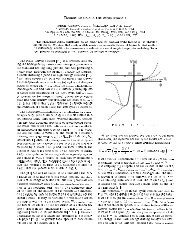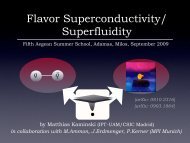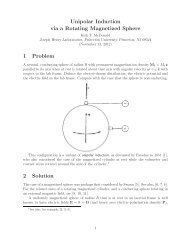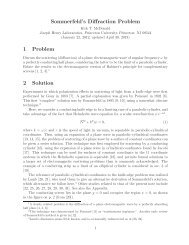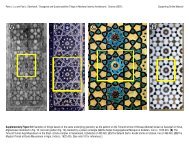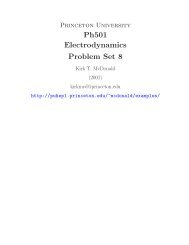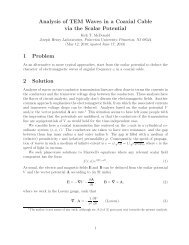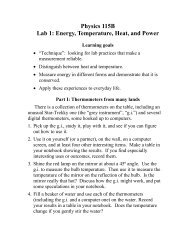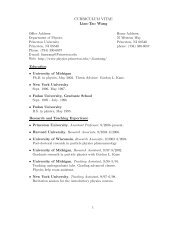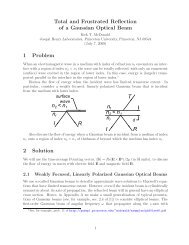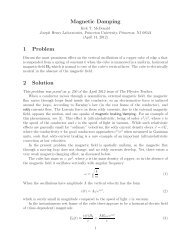Slepian's Electromagnetic Spaceship 1 Problem - Princeton University
Slepian's Electromagnetic Spaceship 1 Problem - Princeton University
Slepian's Electromagnetic Spaceship 1 Problem - Princeton University
Create successful ePaper yourself
Turn your PDF publications into a flip-book with our unique Google optimized e-Paper software.
1 <strong>Problem</strong><br />
Slepian’s <strong>Electromagnetic</strong> <strong>Spaceship</strong><br />
Kirk T. McDonald<br />
Joseph Henry Laboratories, <strong>Princeton</strong> <strong>University</strong>, <strong>Princeton</strong>, NJ 08544<br />
(June 18, 2006; revised October 25, 2012)<br />
In the late 1940’s Joseph Slepian, a senior engineer at Westinghouse, posed a series of<br />
delightful pedagogic puzzles in the popular journal Electrical Engineering. One of these<br />
concerned how the electric displacement current might or might not be used to provide a<br />
form of rocket propulsion [1].<br />
Slepian reminds us how the time-dependent electric field E C (t) inside a parallel-plate capacitor<br />
that is fed by a current I(t) leads to a magnetic field B(t) both inside and outside the<br />
capacitor. If retardation is neglected in the near zone, this magnetic field can be calculated<br />
using Ampère’s law, as extend by Maxwell to include the displacement current (density),<br />
J displacement = 1 dE C<br />
, (1)<br />
4π dt<br />
in Gaussian units, where for simplicity we suppose that no dielectric media are present.<br />
For a capacitor whose plates have area A, the electric field inside is E C =4πQ/A, sothe<br />
displacement current density is J displacement =(1/A)dQ/dt = I/A. Then, for a loop whose<br />
area lies in a plane between the capacitor plates, the induced magnetic field obeys<br />
∮<br />
B · dl = 4π c<br />
∫<br />
J displacement · dArea loop = 4π c I ⎧<br />
⎪⎨<br />
⎪ ⎩<br />
1<br />
A loop<br />
A<br />
(A loop >A),<br />
(A loop
The displacement current (density) J displacement is “real” in the sense that it leads to<br />
magnetic fields according to the same law (2) as holds for conduction currents. However,<br />
Slepian also reminds us that if the displacement current is placed in an external magnetic<br />
field, say B 0 , then it does NOT experience a force (density) that is the analog of the force<br />
(density) J/c × B 0 on a conduction current (density) J.<br />
We now can appreciate Slepian’s suggestion for rocket propulsion based on displacement<br />
current. First, consider a coil as shown on the left below, in which the solenoid winding<br />
creates a field B 0 (t) when excited by an AC current I(t). The solenoid winding is split into<br />
two halves, with a straight segment of wire joining the two halves by crossing the solenoid<br />
field B 0 at a right angle. A length l of this wire experiences a sideways magnetic force<br />
F B = Il × B 0<br />
. (3)<br />
c<br />
The total force of the circuit on itself is zero, so each half of the solenoid experiences a force<br />
−F B /2, which is due to the interaction of the currents in the solenoid windings with the<br />
magnetic field due to the current in the wire segment of length l.<br />
However, if the wire segment of length l is replaced by a parallel-plate capacitor of gap<br />
width l, as shown on the right above, there is no force on the displacement current of the<br />
capacitor, while the magnetic field created by that displacement current does exert force<br />
−F B /2 on each half of the solenoid winding. Thus, the total force on the circuit with the<br />
capacitor is unbalanced, i.e., −F B , and it appears that the circuit will be propelled to the<br />
left.<br />
Note that if the current I is reversed then the magnetic fields are also reversed, but the<br />
magnetic forces do NOT change sign, being the cross product of the current and the field. So,<br />
the unbalanced force is always to the left, and it appears that Slepian’s AC circuit provides<br />
anewformapropulsion.<br />
Explain why Slepian’s rocket motor does not work.<br />
2
2 Solution<br />
The solution follows Slepian [2], and expands upon a subtle point.<br />
2.1 Slepian’s Solution<br />
Not only does a changing electric field create additional magnetic field, but also a changing<br />
magnetic field induces an additional electric field E ind , as first noted by Faraday. Indeed,<br />
Faraday’s law can be put in a form similar to eq. (2) by defining a “magnetic displacement<br />
current”tobeJ magnetic displacement =(1/4π)dB 0 /dt, sothat<br />
∮<br />
E ind · dl = − 1 ∫<br />
d<br />
B 0 · dArea loop = − 4π ∫<br />
J magnetic displacement · dArea loop . (4)<br />
c dt<br />
c<br />
Taking the loop to be in a plane perpendicular to the field B 0 of the solenoid winding, we<br />
see that the “magnetic displacement current” induces an electric field E ind that circulates<br />
around B 0 as shown in the figure below. This induced electric field interacts with the charges<br />
on the capacitor plates and exerts a sideways force on them.<br />
We adopt a coordinate system in which the x-axis is the axis of the solenoid. The<br />
capacitor is centered on the origin, with its plates parallel to the x-y plane and its electric<br />
field along the z-axis. Then, for a loop of radius ρ in the y-z plane with its center on the<br />
x-axis, and which lies within the region of the uniform magnetic field of the solenoid, we find<br />
using Faraday’s law that<br />
E ind = − ρ dB 0<br />
2c dt . (5)<br />
The component E ind,y of the induced electric field that is parallel to the capacitor plates,<br />
3
whose separation is l, is<br />
E ind,y = l/2<br />
ρ E ind = − l dB 0<br />
4c dt , (6)<br />
independent of position on the plates. The charge Q on each plate is conveniently expressed<br />
in terms of the electric field E C =4πQ/A that is perpendicular to the plates. Thus, the<br />
sideways electric force on the two plates is<br />
F E =2QE ind,y ŷ =2 E CA<br />
4π<br />
× −l dB 0<br />
4c dt<br />
= − 1 ∫<br />
8πc<br />
E × dB 0<br />
dt<br />
dVol, (7)<br />
noting that E = E C + E ind ,andthat ∫ E ind × B 0 dVol = 0.<br />
It is useful to rewrite the magnetic force (3) in a manner similar to the last form of<br />
eq. (7). Recalling that I = dQ/dt =(A/4π)dE C /dt, wehave<br />
F B = Il × B 0<br />
c<br />
= Al dE C<br />
4πc dt<br />
The total force on the solenoid + capacitor is<br />
F = F E − F B = − 1 ∫<br />
4πc<br />
= − dP field<br />
dt<br />
where<br />
E × dB 0<br />
dt dVol − 1 ∫<br />
4πc<br />
× B 0 = 1 ∫ dE<br />
4πc dt × B 0 dVol. (8)<br />
dE<br />
dt × B 0 dVol = − d ∫<br />
dt<br />
E × B0<br />
4πc<br />
dVol<br />
, (9)<br />
∫ E × B0<br />
P field = dVol (10)<br />
4πc<br />
is the electromagnetic field momentum introduced by Poincaré [3], building on the Poynting<br />
vector description of energy flow in electromagnetic fields [4]. Since the total force F equals<br />
the rate of change of mechanical momentum of the system, according to Newton, we have<br />
that<br />
0=F + dP field<br />
dt<br />
= dP mech<br />
dt<br />
+ dP field<br />
dt<br />
= dP total<br />
dt<br />
. (11)<br />
Hence the total momentum of the system is constant, which means that the center of<br />
mass/energy of the system is either at rest or in a state of uniform motion. The electromagnetic<br />
forces F E and F B cause small oscillatory motion of the mechanical parts of the<br />
system relative to its center of mass energy, but there is no net propulsion. 1<br />
References<br />
[1] J. Slepian, <strong>Electromagnetic</strong> Space-Ship, Electrical Engineering 68, 145 (1949),<br />
http://puhep1.princeton.edu/~mcdonald/examples/EM/slepian_ee_68_145_49<br />
[2] J. Slepian, Answer to Previous Essay, Electrical Engineering 68, 245 (1949),<br />
http://puhep1.princeton.edu/~mcdonald/examples/EM/slepian_ee_68_245_49<br />
1 For a related paradox, see [5].<br />
4
[3] H. Poincaré, La Théorie de Lorentz et la Principe de Réaction, Arch. Neer. 5, 252<br />
(1900), http://puhep1.princeton.edu/~mcdonald/examples/EM/poincare_an_5_252_00.pdf<br />
Translation: The Theory of Lorentz and the Principle of Reaction,<br />
http://puhep1.princeton.edu/~mcdonald/examples/EM/poincare_an_5_252_00_english.pdf<br />
[4] J.H. Poynting, On the Transfer of Energy in the <strong>Electromagnetic</strong> Field, Phil. Trans.<br />
Roy. Soc. London 175, 343 (1884),<br />
http://puhep1.princeton.edu/~mcdonald/examples/EM/poynting_ptrsl_175_343_84.pdf<br />
[5] K.T. McDonald, Onoochin’s Paradox (Jan. 1, 2006),<br />
http://puhep1.princeton.edu/~mcdonald/examples/onoochin.pdf<br />
5



